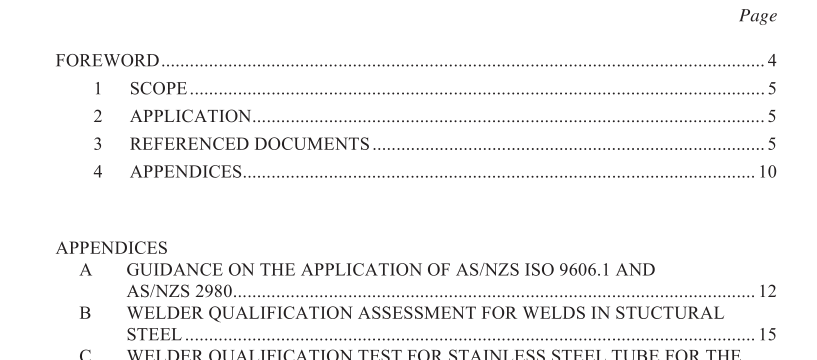AS NZS 2980:2018 pdf free download
AS NZS 2980:2018 pdf free download.Qualification of welders for fusion welding of steels- Additional requirements for Australia and New Zealand
B3.7.1 Method
If ultrasonic examination is used in lieu of the radiographic examination for ferritic steels (see AS/NZS ISO 9606.1 Table 13), it shall conform to AS 2207. Shear probes shall have a dominant frequency in the range 2.0 MHz to 2.5 MHz, and an essentially square or circular transducer in the size range 15 mm to 22 mm. For plate thicknesses of less than 15 mm,the transducer size may be reduced to 8 mm and frequencies increased to 5 MHz. Compression probes shall have a dominant frequency in the range 4 MHz to 5 MHz, and an essentially square or circular transducer in the size range 10mmto20mm.
B3.7.2 Evaluation
For welds on material with a thickness not greater than 50 mm, evaluation shall be carried out at Level 2, in accordance with AS 2207. For welds on material with thickness greater than 50 mm, evaluation shall be carried out at Level 3. Planar imperfections should be evaluated at an incident angle of less than 10°. Where this is not possible, additional gain shall be added in accordance with Table B3.7.2. For the purposes of Table B3.7.2, planar imperfections shall be considered to lie along the welding preparation faces. The probe angle shall be the actual measured angle, not the nominal angle.
NOTES: 1 For adjacent imperfections, see Paragraph B3.6.3(b).
2 For the purpose of radiographic and ultrasonic examination, h is to be taken as 2 mm. If the radiographic or ultrasonic examination indicates that height could be greater than 2 mm, h is to be determined by sectioning or vertical ultrasonic sizing in accordance with AS 2207.
3 For any length under consideration, the imperfection level shall be calculated by multiplying the length of each imperfection by its weighting factor and adding these weighted lengths to determine a total imperfection level. The total imperfection level shall be less than the maximum permissible imperfection level.
4 Any imperfections shall not exceed a height equal to the greater of 2 mm and t/20, within a distance oft of the end of a weld.
5 Porosity is not considered to be a particularly serious imperfection and is cause for rejection of a weld only where it is present in sufficient quantity to render difficult an inspection for the other imperfections listed in Table B3.6.3. For radiographic inspections, porosity levels representing a loss of projected area of not more than 2% are permitted. If required, reference may be made to porosity charts in AS 4037, to assist in assessing the appearance of this level of porosity on a radiograph.
AS NZS 2980:2018 pdf free download
